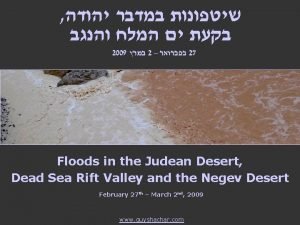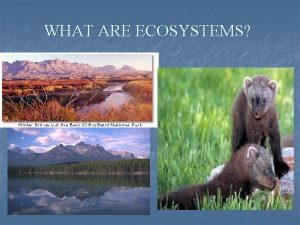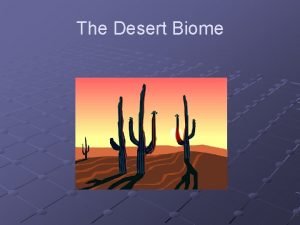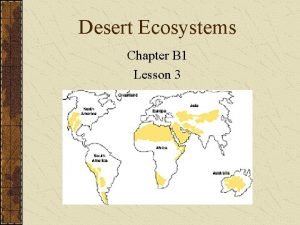What Is a Desert A desert is any













- Slides: 13


What Is a Desert? A desert is any place that gets less than 25 cm of rainfall a year. Deserts cover 1/5 of the There are deserts on all continents. world’s land surface. Deserts are part of a land type called drylands. These areas often lose more moisture through evaporation than they get in rainfall.

Where Are Deserts? Here are some of the world’s largest deserts. Sahara Gobi Patagonia Syrian Kalahari Arabian Great Victoria

What Are Deserts Like? We Some tend to think however that all deserts are hot. The Sahara regularly has of deserts are actually cold. Winter temperatures in temperatures the Gobi desert 50°C during the day. The highest recorded can reach -40°C. The world’s largest deserts are in thetemperature Arctic and Antarctic. in Death Valley in the USA was 56. 7°C. The Gobi Desert Did You Know? Only 20% of the earth’s deserts are covered in sand.

What Plants Live in the Desert? Despite the harsh conditions, many plants live in the deserts. Cacti (the plural of. California cactus) are Bougainvillea and suited toare desert life. When there is poppies examples of flowering moisture in the air, aincactus plants which bloom the desert swellsthere to store water. after has the been rain. A cactus has spikes instead of leaves in order trees to conserve the water. The Palm grow in some deserts. spikes palm also ward animals that These trees off don’t usually mightfruit. try to. They eat the grow are cactus. good at storing water.

What Animals Live in the Desert? Animals that are adapted to living in the desert are known as xerocoles. Click on a picture to find out more about some of these animals. camel meerkat sidewinder fennec fox scorpion lizard

Camel A camel’s hump stores fat that can be converted into energy when food is scarce. To protect themselves from sandstorms, they have long eye lashes and their nostrils can close to keep sand out. Camel’s feet are wide to avoid slipping through sand. The soles of their feet are thick pads to avoid burns from the hot sand. back

Meerkat The dark rings around a meerkat's eyes reduces the glare of the hot desert sun. Their eyes also have a transparent layer which protects their eyes while they are digging into the sand to make burrows. The layer of fur on a meerkat’s stomach is thin. This means when they lie on their backs in the sun, their bodies warm up quickly. Meerkats prey on many animals in the desert, including rodents, birds and scorpions. back

Sidewinders are rattlesnakes that live in some of the hottest deserts on earth. They are known for the strange patterns their movements leave in the sand. A sidewinder’s colouring means it is camouflaged against the sand. This makes it easier for it to catch its prey. Unlike most species of snake, female sidewinders are larger than males. They can move at speeds of up to 29 km per hour. back

Fennec Fox Fennec foxes, also called desert foxes, are known for their very large ears. The ears help them listen for their prey. The ears also help heat to leave the fox’s body. The long thick fur protects the fox’s skin from the sun during the day and keeps the fox warm in the cool desert nights. The hair on the fox’s feet protects it from hot sand. The feet are specially shaped to make it easy for the fox to dig their underground dens. back

Scorpions are arachnids, which means they are in the same family as spiders. Scorpions can slow down the amount of energy they get from food so they can survive on a very small amount of food in the desert. They avoid the heat of the desert by burrowing underneath the sand. 30 – 40 species of scorpion have a sting strong enough to kill a human! back

Lizards are cold-blooded animals, so they rely on their environment to help warm them up. They use the hot desert sun to get warm. Some lizards have spiny scales on their toes to help them run across the sand instead of sinking into it. A lizard’s claws help it burrow underneath the sand to help it escape the hot sun and also flee from predators. Some lizards have clear membranes over their eyes to protect them while they burrow. back

 The soldier decided to desert his dessert in the desert
The soldier decided to desert his dessert in the desert There is some cake
There is some cake Any to any connectivity
Any to any connectivity Informational probes adalah
Informational probes adalah Great victorian desert map
Great victorian desert map Desert biome climograph
Desert biome climograph You may cross the barren desert
You may cross the barren desert Astrazenicaab
Astrazenicaab Pecos wind power
Pecos wind power Judean desert
Judean desert What is a desert cooler
What is a desert cooler Non living things in freshwater
Non living things in freshwater Evil figure with a good heart archetype
Evil figure with a good heart archetype Thar desert picture
Thar desert picture

























